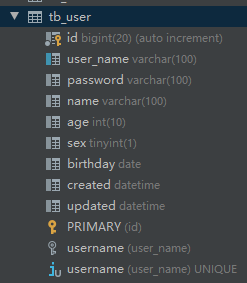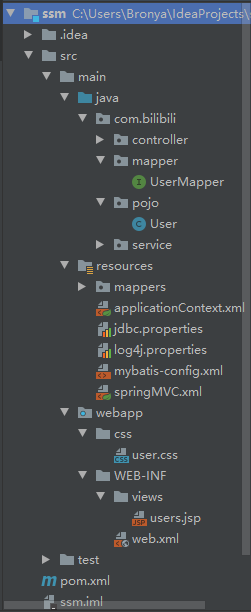SSM整合
SSM 整合
SpringMVC、Spring、Mybatis整合
maven项目打war包并引入依赖,并添加静态资源:依赖及静态资源
<dependencies>
<!-- 单元测试 -->
<dependency>
<groupId>junit</groupId>
<artifactId>junit</artifactId>
<version>4.12</version>
<scope>test</scope>
</dependency>
<!-- Spring -->
<dependency>
<groupId>org.springframework</groupId>
<artifactId>spring-webmvc</artifactId>
<version>5.0.6.RELEASE</version>
</dependency>
<dependency>
<groupId>org.springframework</groupId>
<artifactId>spring-jdbc</artifactId>
<version>5.0.6.RELEASE</version>
</dependency>
<dependency>
<groupId>org.springframework</groupId>
<artifactId>spring-aspects</artifactId>
<version>5.0.6.RELEASE</version>
</dependency>
<!-- Mybatis -->
<dependency>
<groupId>org.mybatis</groupId>
<artifactId>mybatis</artifactId>
<version>3.2.8</version>
</dependency>
<dependency>
<groupId>org.mybatis</groupId>
<artifactId>mybatis-spring</artifactId>
<version>1.2.2</version>
</dependency>
<!-- MySql -->
<dependency>
<groupId>mysql</groupId>
<artifactId>mysql-connector-java</artifactId>
<version>5.1.32</version>
</dependency>
<dependency>
<groupId>org.slf4j</groupId>
<artifactId>slf4j-log4j12</artifactId>
<version>1.6.4</version>
</dependency>
<!-- Jackson Json处理工具包 -->
<dependency>
<groupId>com.fasterxml.jackson.core</groupId>
<artifactId>jackson-databind</artifactId>
<version>2.9.0</version>
</dependency>
<!-- 连接池 -->
<dependency>
<groupId>com.alibaba</groupId>
<artifactId>druid</artifactId>
<version>1.0.9</version>
</dependency>
<!-- JSP相关 -->
<dependency>
<groupId>jstl</groupId>
<artifactId>jstl</artifactId>
<version>1.2</version>
</dependency>
<dependency>
<groupId>javax.servlet</groupId>
<artifactId>javax.servlet-api</artifactId>
<version>3.0.1</version>
<scope>provided</scope>
</dependency>
<dependency>
<groupId>javax.servlet</groupId>
<artifactId>jsp-api</artifactId>
<version>2.0</version>
<scope>provided</scope>
</dependency>
</dependencies>css文件及页面资源:
/*表格样式*/
table.altrowstable {
font-family: verdana, arial, sans-serif;
font-size: 11px;
color: #333333;
border-width: 1px;
border-color: #a9c6c9;
border-collapse: collapse;
}
table.altrowstable th {
border-width: 1px;
padding: 30px;
border-style: solid;
border-color: #a9c6c9;
}
table.altrowstable td {
border-width: 1px;
padding: 10px;
border-style: solid;
border-color: #a9c6c9;
text-align: center;
}在WEB-INF下创建views文件夹,并创建users.jsp文件:
<%@ page contentType="text/html;charset=UTF-8" language="java" %>
<%@ taglib prefix="c" uri="http://java.sun.com/jsp/jstl/core" %>
<%@ taglib prefix="f" uri="http://java.sun.com/jsp/jstl/fmt" %>
<html>
<head>
<title>Title</title>
<link rel="stylesheet" href="/css/user.css"/>
</head>
<body>
<!-- Table goes in the document BODY -->
<table class="altrowstable" id="alternatecolor">
<tr>
<th>用户编号</th>
<th>用户名</th>
<th>真实姓名</th>
<th>年龄</th>
<th>性别</th>
<th>出生日期</th>
<th>创建日期</th>
<th>更新日期</th>
<th>删除操作</th>
</tr>
<c:forEach var="user" items="${userList}">
<tr>
<td>${user.id}</td>
<td>${user.userName}</td>
<td>${user.name}</td>
<td>${user.age}</td>
<td>${user.sex==1?"男":"女"}</td>
<td><f:formatDate value="${user.birthday}" pattern="yyyy-MM-dd"></f:formatDate></td>
<td><f:formatDate value="${user.created}" pattern="yyyy-MM-dd"></f:formatDate></td>
<td> <f:formatDate value="${user.updated}" pattern="yyyy-MM-dd"></f:formatDate> </td>
<td><a href="/user/deleteUserById?id=100">删除</a></td>
</tr>
</c:forEach>
</table>
</body>
</html>创建数据库及实体类: 数据库及实体类
创建如图所示数据库并插入测试数据:

按照数据库创建实体类:
public class User {
private Long id;
// 用户名
private String userName;
// 密码
private String password;
// 姓名
private String name;
// 年龄
private Integer age;
// 性别,1男性,2女性
private Integer sex;
// 出生日期
private Date birthday;
// 创建时间
private Date created;
// 更新时间
private Date updated;
@Override
public String toString() {
return "User{" +
"id=" + id +
", userName='" + userName + '\'' +
", password='" + password + '\'' +
", name='" + name + '\'' +
", age=" + age +
", sex=" + sex +
", birthday=" + birthday +
", created=" + created +
", updated=" + updated +
'}';
}
public Long getId() {
return id;
}
public void setId(Long id) {
this.id = id;
}
public String getUserName() {
return userName;
}
public void setUserName(String userName) {
this.userName = userName;
}
public String getPassword() {
return password;
}
public void setPassword(String password) {
this.password = password;
}
public String getName() {
return name;
}
public void setName(String name) {
this.name = name;
}
public Integer getAge() {
return age;
}
public void setAge(Integer age) {
this.age = age;
}
public Integer getSex() {
return sex;
}
public void setSex(Integer sex) {
this.sex = sex;
}
public Date getBirthday() {
return birthday;
}
public void setBirthday(Date birthday) {
this.birthday = birthday;
}
public Date getCreated() {
return created;
}
public void setCreated(Date created) {
this.created = created;
}
public Date getUpdated() {
return updated;
}
public void setUpdated(Date updated) {
this.updated = updated;
}
}创建mapper接口即mybatis相关配置文件: Mybatis相关
UserMapper接口:
public interface UserMapper {
public User findUserById(Long id);
}创建mybatis-config.xml核心配置文件
<?xml version="1.0" encoding="UTF-8" ?>
<!DOCTYPE configuration
PUBLIC "-//mybatis.org//DTD Config 3.0//EN"
"http://mybatis.org/dtd/mybatis-3-config.dtd">
<configuration>
<!-- 加载外部的jdbc.properties -->
<properties resource="jdbc.properties"></properties>
<typeAliases>
<!-- 配置pojo的别名映射 -->
<package name="com.bilibili.pojo"></package>
</typeAliases>
<environments default="development">
<environment id="development">
<transactionManager type="JDBC"/>
<dataSource type="POOLED">
<property name="driver" value="${jdbc.driverClass}"/>
<property name="url" value="${jdbc.url}"/>
<property name="username" value="${jdbc.username}"/>
<property name="password" value="${jdbc.password}"/>
</dataSource>
</environment>
</environments>
<mappers>
<mapper resource="mappers/UserMapper.xml"></mapper>
</mappers>
</configuration>添加log4j.properties和jdbc.properties配置:
log4j.properties:
### direct log messages to stdout ###
### 配置输出源的 log4j.appender.输出源名=输出源的实现类
### 属性的配置 log4j.appender.输出源名.属性名=属性值
log4j.appender.a=org.apache.log4j.ConsoleAppender
log4j.appender.a.Target=System.out
log4j.appender.a.layout=org.apache.log4j.PatternLayout
log4j.appender.a.layout.ConversionPattern=%-d{yyyy-MM-dd HH:mm:ss,SSS} [%t] [%c]-[%p] %m%n
### set log levels - for more verbose logging change 'info' to 'debug' ###
### log4j.rootLogger=输出级别,输出源1,输出源2....
log4j.rootLogger=debug, ajdbc.properties:
jdbc.driverClass = com.mysql.jdbc.Driver
jdbc.url = jdbc:mysql://localhost:3306/mybatis
jdbc.username = root
jdbc.password = 1234创建接口映射userMapper.xml:
<?xml version="1.0" encoding="UTF-8" ?>
<!DOCTYPE mapper
PUBLIC "-//mybatis.org//DTD Mapper 3.0//EN"
"http://mybatis.org/dtd/mybatis-3-mapper.dtd">
<!-- 接口的全限定名 -->
<mapper namespace="com.bilibili.mapper.UserMapper">
<!-- statement的id就是方法的名字 -->
<select id="findUserById" resultType="User">
select * from tb_user where id = #{id}
</select>
</mapper>此时文件结构如下:

创建Mapper测试类测试mybatis:Mybatis测试类
public class UserMapperTest {
private UserMapper userMapper;
@Before
public void setUp() throws Exception {
InputStream is = Resources.getResourceAsStream("mybatis-config.xml");
SqlSessionFactory sqlSessionFactory = new SqlSessionFactoryBuilder().build(is);
SqlSession sqlSession = sqlSessionFactory.openSession(true);
userMapper = sqlSession.getMapper(UserMapper.class);
}
@Test
public void findUserById() {
User user = userMapper.findUserById(1L);
System.out.println(user);
}
}Spring与Mybatis整合
添加mybatis-spring依赖:
<dependency>
<groupId>org.mybatis</groupId>
<artifactId>mybatis-spring</artifactId>
<version>1.3.3</version>
</dependency>Mybatis和spring的整合包提供了一个SqlSessionFactoryBean,该对象是一个工厂bean,实现了FactoryBean,可以通过其getObject方法来返回一个SqlSessionFactory。(实现FactoryBean接口之后,获取该bean时会使用其getObject方法)
创建spring主配置文件applicationContext.xml,并修改mybatis主配置文件:
通过配置SqlSessionFactoryBean的bean来将SqlSessionFactory交给spring来管理。(需要注入 数据源dataSource、mybatis核心文件位置configLocation、别名映射typeAliasesPackage、mapper文件mapperLocations)spring与mybatis主配置文件
applicationContext.xml:
<?xml version="1.0" encoding="UTF-8"?>
<beans xmlns="http://www.springframework.org/schema/beans"
xmlns:xsi="http://www.w3.org/2001/XMLSchema-instance"
xmlns:context="http://www.springframework.org/schema/context"
xsi:schemaLocation="
http://www.springframework.org/schema/beans
http://www.springframework.org/schema/beans/spring-beans.xsd
http://www.springframework.org/schema/context
http://www.springframework.org/schema/context/spring-context.xsd">
<!-- 加载外部配置文件 -->
<context:property-placeholder location="classpath:jdbc.properties"></context:property-placeholder>
<!-- bean definitions here -->
<!-- 装配sqlSessionFactory对象 -->
<bean id="sqlSessionFactory" class="org.mybatis.spring.SqlSessionFactoryBean">
<!-- 配置数据源 -->
<property name="dataSource" ref="dataSource"></property>
<!-- 配置mybatis核心配置文件的位置 -->
<property name="configLocation" value="classpath:mybatis-config.xml"></property>
<!-- 将mybatis中的别名映射配置 转移 到spring中来-->
<property name="typeAliasesPackage" value="com.bilibili.pojo"></property>
<!-- 将mybatis中的映射文件的配置 转移 到spring中来-->
<property name="mapperLocations" value="classpath:mappers/*.xml"></property>
</bean>
<!-- 配置数据源 -->
<bean id="dataSource" class="com.alibaba.druid.pool.DruidDataSource">
<property name="driverClassName" value="${jdbc.driverClass}"></property>
<property name="url" value="${jdbc.url}"></property>
<property name="username" value="${jdbc.username}"></property>
<property name="password" value="${jdbc.password}"></property>
</bean>
</beans>修改mybatis-config.xml配置文件:
<?xml version="1.0" encoding="UTF-8" ?>
<!DOCTYPE configuration
PUBLIC "-//mybatis.org//DTD Config 3.0//EN"
"http://mybatis.org/dtd/mybatis-3-config.dtd">
<configuration>
<settings>
<!-- 只剩下驼峰映射 -->
<setting name="mapUnderscoreToCamelCase" value="true"/>
</settings>
</configuration>创建测试类进行测试:
public class UserMapperTest2 {
private UserMapper userMapper;
@Before
public void setUp(){
ApplicationContext ac = new ClassPathXmlApplicationContext("applicationContext.xml");
SqlSessionFactory sqlSessionFactory = (SqlSessionFactory) ac.getBean("sqlSessionFactory");
SqlSession sqlSession = sqlSessionFactory.openSession(true);
userMapper = sqlSession.getMapper(UserMapper.class);
}
@Test
public void findUserById() {
userMapper.findUserById(1l);
}
}此时已将SqlSessionFactory交给Spring来管理,但仍然可以继续整合。
将Mapper接口对象也交给Spring管理:
在Spring配置中MapperFactoryBean 配置单个Mapper作为bean
<?xml version="1.0" encoding="UTF-8"?>
<beans xmlns="http://www.springframework.org/schema/beans"
xmlns:xsi="http://www.w3.org/2001/XMLSchema-instance"
xmlns:context="http://www.springframework.org/schema/context"
xsi:schemaLocation="
http://www.springframework.org/schema/beans
http://www.springframework.org/schema/beans/spring-beans.xsd
http://www.springframework.org/schema/context
http://www.springframework.org/schema/context/spring-context.xsd">
<!-- 加载外部配置文件 -->
<context:property-placeholder location="classpath:jdbc.properties"></context:property-placeholder>
<!-- bean definitions here -->
<!-- 装配sqlSessionFactory对象 -->
<bean id="sqlSessionFactory" class="org.mybatis.spring.SqlSessionFactoryBean">
<!-- 配置数据源 -->
<property name="dataSource" ref="dataSource"></property>
<!-- 配置mybatis核心配置文件的位置 -->
<property name="configLocation" value="classpath:mybatis-config.xml"></property>
<property name="typeAliasesPackage" value="com.bilibili.pojo"></property>
<property name="mapperLocations" value="classpath:mappers/*.xml"></property>
</bean>
<!-- 配置单个userMapper对象 -->
<bean id="userMapper" class="org.mybatis.spring.mapper.MapperFactoryBean">
<!-- 配置sqlSessionFacotroy对象 -->
<property name="sqlSessionFactory" ref="sqlSessionFactory"></property>
<!-- 配置userMapper对象的接口 -->
<property name="mapperInterface" value="com.bilibili.mapper.UserMapper"></property>
</bean>
<!-- 配置数据源 -->
<bean id="dataSource" class="com.alibaba.druid.pool.DruidDataSource">
<property name="driverClassName" value="${jdbc.driverClass}"></property>
<property name="url" value="${jdbc.url}"></property>
<property name="username" value="${jdbc.username}"></property>
<property name="password" value="${jdbc.password}"></property>
</bean>
</beans>此时已经将mapper接口也交个spring来管理,不过mapper一个一个配置太麻烦,可以修改为包扫描的方式:
<!-- 配置包扫描方式,创建多个mapper -->
<bean class="org.mybatis.spring.mapper.MapperScannerConfigurer">
<property name="basePackage" value="com.bilibili.mapper" />
<property name="sqlSessionFactoryBeanName" value="sqlSessionFactory" />
</bean>最终配置: spring配置文件即mybatis配置文件最终结果
applicationContext.xml:
<?xml version="1.0" encoding="UTF-8"?>
<beans xmlns="http://www.springframework.org/schema/beans"
xmlns:xsi="http://www.w3.org/2001/XMLSchema-instance"
xmlns:context="http://www.springframework.org/schema/context"
xsi:schemaLocation="
http://www.springframework.org/schema/beans
http://www.springframework.org/schema/beans/spring-beans.xsd
http://www.springframework.org/schema/context
http://www.springframework.org/schema/context/spring-context.xsd">
<!-- 加载外部配置文件 -->
<context:property-placeholder location="classpath:jdbc.properties"></context:property-placeholder>
<!-- bean definitions here -->
<!-- 装配sqlSessionFactory对象 -->
<bean id="sqlSessionFactory" class="org.mybatis.spring.SqlSessionFactoryBean">
<!-- 配置数据源 -->
<property name="dataSource" ref="dataSource"></property>
<!-- 配置mybatis核心配置文件的位置 -->
<property name="configLocation" value="classpath:mybatis-config.xml"></property>
<property name="typeAliasesPackage" value="com.bilibili.pojo"></property>
<property name="mapperLocations" value="classpath:mappers/*.xml"></property>
</bean>
<!-- 配置数据源 -->
<bean id="dataSource" class="com.alibaba.druid.pool.DruidDataSource">
<property name="driverClassName" value="${jdbc.driverClass}"></property>
<property name="url" value="${jdbc.url}"></property>
<property name="username" value="${jdbc.username}"></property>
<property name="password" value="${jdbc.password}"></property>
</bean>
<!-- 配置包扫描方式,创建多个mapper -->
<bean class="org.mybatis.spring.mapper.MapperScannerConfigurer">
<property name="basePackage" value="com.bilibili.mapper" />
<property name="sqlSessionFactoryBeanName" value="sqlSessionFactory" />
</bean>
</beans>mybati-config.xml:
<?xml version="1.0" encoding="UTF-8" ?>
<!DOCTYPE configuration
PUBLIC "-//mybatis.org//DTD Config 3.0//EN"
"http://mybatis.org/dtd/mybatis-3-config.dtd">
<configuration>
<settings>
<setting name="mapUnderscoreToCamelCase" value="true"/>
</settings>
</configuration>Spring与SpringMVC整合
创建springMVC.xml文件,并配置web.xml文件:springMVC配置文件即web.xml文件
<?xml version="1.0" encoding="UTF-8"?>
<beans xmlns="http://www.springframework.org/schema/beans"
xmlns:xsi="http://www.w3.org/2001/XMLSchema-instance" xmlns:p="http://www.springframework.org/schema/p"
xmlns:context="http://www.springframework.org/schema/context"
xmlns:mvc="http://www.springframework.org/schema/mvc"
xsi:schemaLocation="http://www.springframework.org/schema/beans
http://www.springframework.org/schema/beans/spring-beans.xsd
http://www.springframework.org/schema/mvc
http://www.springframework.org/schema/mvc/spring-mvc.xsd
http://www.springframework.org/schema/context
http://www.springframework.org/schema/context/spring-context.xsd">
<!-- 开启注解驱动 -->
<mvc:annotation-driven></mvc:annotation-driven>
<!-- 扫描指定包下的注解 -->
<context:component-scan base-package="com.bilibili.controller"></context:component-scan>
<!-- 配置视图解析器 -->
<bean class="org.springframework.web.servlet.view.InternalResourceViewResolver">
<!-- 返回的视图前缀(Json的话不需要这玩意) -->
<property name="prefix" value="WEB-INF/views/"></property>
<!-- 后缀 -->
<property name="suffix" value=".jsp"></property>
</bean>
<!-- 放行静态资源 -->
<mvc:default-servlet-handler></mvc:default-servlet-handler>
</beans>配置web.xml,配置乱码过滤器,springMVC的前端控制器,spring的监听器:
<?xml version="1.0" encoding="UTF-8"?>
<web-app xmlns="http://java.sun.com/xml/ns/javaee"
xmlns:xsi="http://www.w3.org/2001/XMLSchema-instance"
xsi:schemaLocation="http://java.sun.com/xml/ns/javaee
http://java.sun.com/xml/ns/javaee/web-app_3_0.xsd"
version="3.0">
<!-- 乱码过滤器 -->
<filter>
<filter-name>CharacterEncodingFilter</filter-name>
<filter-class>org.springframework.web.filter.CharacterEncodingFilter</filter-class>
<init-param>
<param-name>encoding</param-name>
<param-value>utf-8</param-value>
</init-param>
</filter>
<filter-mapping>
<filter-name>CharacterEncodingFilter</filter-name>
<url-pattern>/*</url-pattern>
</filter-mapping>
<!-- 前端控制器 -->
<servlet>
<servlet-name>DispatcherServlet</servlet-name>
<servlet-class>org.springframework.web.servlet.DispatcherServlet</servlet-class>
<init-param>
<!-- 配置springMVC核心配置文件的位置 -->
<param-name>contextConfigLocation</param-name>
<param-value>classpath:springMVC.xml</param-value>
</init-param>
</servlet>
<servlet-mapping>
<servlet-name>DispatcherServlet</servlet-name>
<!-- 拦截的路径 -->
<url-pattern>*.do</url-pattern>
</servlet-mapping>
<!-- spring的监听器 -->
<listener>
<listener-class>org.springframework.web.context.ContextLoaderListener</listener-class>
</listener>
<context-param>
<!-- spring核心配置文件 -->
<param-name>contextConfigLocation</param-name>
<param-value>classpath:applicationContext.xml</param-value>
</context-param>
</web-app>创建一个测试Controller: 测试Controller
@Controller
public class UserController {
@Autowired
private UserService userService;
@RequestMapping("findAllUsers")
public String findAllUsers(Model model){
//1.调用service查询所有数据
List<User> userList = userService.findAllUsers();
//2.将数据转发到jsp页面去
model.addAttribute("userList",userList);
return "users";
}
}创建UserService接口并创建其实现类: UserServiceImpl
@Service //注册当前是一个service层的bean到spring容器
public class UserServiceImpl implements UserService {
@Autowired //自动根据类型注入
private UserMapper userMapper;
public List<User> findAllUsers() {
//调用dao层查询所有用户信息
return userMapper.findAllUsers();
}
}编写接口及其mapper.xmlmapper接口及其映射xml
接口中添加方法:
public List<User> findAllUsers();xml中添加SQL语句
<select id="findAllUsers" resultType="User">
select * from tb_user
</select>在spring中开启service层注解扫描:
<!-- 注解扫描service -->
<context:component-scan base-package="com.bilibili.service"></context:component-scan>Service整合事务
在controller中调用添加用户方法: web层
@RequestMapping("addUsers")
public String addUsers(){
//调用service新增2个用户信息
userService.addUsers();
//重定向到查询用户页面去
return "redirect:findAllUsers";
}Service层添加两个用户: Service层
public void addUsers() {
User user = new User();
user.setUserName("zzzxxx");
user.setPassword("zzzxxx");
User user2 = new User();
user2.setUserName("zzzxxx2");
user2.setPassword("zzzxxx2");
userMapper.addUser(user);
//测试事务用的错误
//int i = 1/0;
userMapper.addUser(user2);
}持久层添加方法: dao层
public void addUser(User user);<insert id="addUser">
insert into tb_user(user_name,password) values(#{userName},#{password})
</insert>spring中盘配置事务管理器、事务策略、事务AOP: 事务相关
<?xml version="1.0" encoding="UTF-8"?>
<beans xmlns="http://www.springframework.org/schema/beans"
xmlns:xsi="http://www.w3.org/2001/XMLSchema-instance"
xmlns:context="http://www.springframework.org/schema/context"
xmlns:tx="http://www.springframework.org/schema/tx"
xmlns:aop="http://www.springframework.org/schema/aop"
xsi:schemaLocation="http://www.springframework.org/schema/beans
http://www.springframework.org/schema/beans/spring-beans.xsd
http://www.springframework.org/schema/context
http://www.springframework.org/schema/context/spring-context.xsd
http://www.springframework.org/schema/tx
http://www.springframework.org/schema/tx/spring-tx.xsd
http://www.springframework.org/schema/aop
http://www.springframework.org/schema/aop/spring-aop.xsd">
<!-- 注解扫描service -->
<context:component-scan base-package="com.bilibili.service"></context:component-scan>
<!-- 加载外部配置文件 -->
<context:property-placeholder location="classpath:jdbc.properties"></context:property-placeholder>
<!-- bean definitions here -->
<!-- 装配sqlSessionFactory对象 -->
<bean id="sqlSessionFactory" class="org.mybatis.spring.SqlSessionFactoryBean">
<!-- 配置数据源 -->
<property name="dataSource" ref="dataSource"></property>
<!-- 配置mybatis核心配置文件的位置 -->
<property name="configLocation" value="classpath:mybatis-config.xml"></property>
<property name="typeAliasesPackage" value="com.bilibili.pojo"></property>
<property name="mapperLocations" value="classpath:mappers/*.xml"></property>
</bean>
<!-- 配置数据源 -->
<bean id="dataSource" class="com.alibaba.druid.pool.DruidDataSource">
<property name="driverClassName" value="${jdbc.driverClass}"></property>
<property name="url" value="${jdbc.url}"></property>
<property name="username" value="${jdbc.username}"></property>
<property name="password" value="${jdbc.password}"></property>
</bean>
<!-- 配置包扫描方式,创建多个mapper -->
<bean class="org.mybatis.spring.mapper.MapperScannerConfigurer">
<property name="basePackage" value="com.bilibili.mapper" />
<property name="sqlSessionFactoryBeanName" value="sqlSessionFactory" />
</bean>
<!-- 配置事务管理器 -->
<bean id="transactionManager" class="org.springframework.jdbc.datasource.DataSourceTransactionManager">
<property name="dataSource" ref="dataSource"></property>
</bean>
<!-- 配置事务策略 -->
<tx:advice id="txAdvice">
<tx:attributes>
<tx:method name="*"/>
</tx:attributes>
</tx:advice>
<!-- 配置aop -->
<aop:config>
<aop:pointcut id="transaction" expression="execution(* com.bilibili.service.impl.*.*(..))"></aop:pointcut>
<aop:advisor advice-ref="txAdvice" pointcut-ref="transaction" ></aop:advisor>
</aop:config>
</beans>注解方式配置事务:
spring配置中开启事务注解:
<!-- 开启注解事务 -->
<tx:annotation-driven></tx:annotation-driven>然后在实现类上添加@Transaction即可:
@Transactional//当前实现类的所有方法添加事务
@Service
public class UserServiceImpl implements UserService {}配置文件优化
将applicationContext.xml拆分成三个文件:
1. applicationContext-tx.xml:事务相关的。
2. applicationContext-mybatis:mybatis相关的。
3. applicationContext.xml:注解扫描和数据源相关的Spring配置文件拆分: 配置文件拆分
事务相关的 applicationContext-tx.xml
<?xml version="1.0" encoding="UTF-8"?>
<beans xmlns="http://www.springframework.org/schema/beans"
xmlns:xsi="http://www.w3.org/2001/XMLSchema-instance"
xmlns:tx="http://www.springframework.org/schema/tx"
xsi:schemaLocation="http://www.springframework.org/schema/beans
http://www.springframework.org/schema/beans/spring-beans.xsd
http://www.springframework.org/schema/tx
http://www.springframework.org/schema/tx/spring-tx.xsd">
<!-- bean definitions here -->
<!-- 配置事务管理器 -->
<bean id="transactionManager" class="org.springframework.jdbc.datasource.DataSourceTransactionManager">
<property name="dataSource" ref="dataSource"></property>
</bean>
<!-- <!– 配置事务策略 –>
<tx:advice id="txAdvice">
<tx:attributes>
<tx:method name="*"/>
</tx:attributes>
</tx:advice>
<!– 配置aop –>
<aop:config>
<aop:pointcut id="transaction" expression="execution(* com.bilibili.service.impl.*.*(..))"></aop:pointcut>
<aop:advisor advice-ref="txAdvice" pointcut-ref="transaction" ></aop:advisor>
</aop:config>-->
<!-- 开启注解事务 -->
<tx:annotation-driven></tx:annotation-driven>
</beans>mybatis相关的 applicationContext-mybatis.xml
<?xml version="1.0" encoding="UTF-8"?>
<beans xmlns="http://www.springframework.org/schema/beans"
xmlns:xsi="http://www.w3.org/2001/XMLSchema-instance"
xsi:schemaLocation="
http://www.springframework.org/schema/beans
http://www.springframework.org/schema/beans/spring-beans.xsd">
<!-- bean definitions here -->
<!-- 装配sqlSessionFactory对象 -->
<bean id="sqlSessionFactory" class="org.mybatis.spring.SqlSessionFactoryBean">
<!-- 配置数据源 -->
<property name="dataSource" ref="dataSource"></property>
<!-- 配置mybatis核心配置文件的位置 -->
<property name="configLocation" value="classpath:mybatis-config.xml"></property>
<property name="typeAliasesPackage" value="com.bilibili.pojo"></property>
<property name="mapperLocations" value="classpath:mappers/*.xml"></property>
</bean>
<!-- 配置包扫描方式,创建多个mapper -->
<bean class="org.mybatis.spring.mapper.MapperScannerConfigurer">
<property name="basePackage" value="com.bilibili.mapper" />
<property name="sqlSessionFactoryBeanName" value="sqlSessionFactory" />
</bean>
</beans>注解扫描和数据源相关的 applicationContext.xml
<?xml version="1.0" encoding="UTF-8"?>
<beans xmlns="http://www.springframework.org/schema/beans"
xmlns:xsi="http://www.w3.org/2001/XMLSchema-instance"
xmlns:context="http://www.springframework.org/schema/context"
xsi:schemaLocation="http://www.springframework.org/schema/beans
http://www.springframework.org/schema/beans/spring-beans.xsd
http://www.springframework.org/schema/context
http://www.springframework.org/schema/context/spring-context.xsd">
<!-- 注解扫描service -->
<context:component-scan base-package="com.bilibili.service"></context:component-scan>
<!-- 加载外部配置文件 -->
<context:property-placeholder location="classpath:jdbc.properties"></context:property-placeholder>
<!-- bean definitions here -->
<!-- 配置数据源 -->
<bean id="dataSource" class="com.alibaba.druid.pool.DruidDataSource">
<property name="driverClassName" value="${jdbc.driverClass}"></property>
<property name="url" value="${jdbc.url}"></property>
<property name="username" value="${jdbc.username}"></property>
<property name="password" value="${jdbc.password}"></property>
</bean>
</beans>修改web.xml的配置,加载所有的spring的核心配置文件修改web.xml
<!-- spring的监听器 -->
<listener>
<listener-class>org.springframework.web.context.ContextLoaderListener</listener-class>
</listener>
<context-param>
<param-name>contextConfigLocation</param-name>
<param-value>classpath:applicationContext*.xml</param-value>
</context-param>Maven高级
maven打pom包可以作为父项目来同一管理依赖版本:
<!-- 只是声明依赖的版本,不会真的引入依赖,子工程通过坐标引入依赖 -->
<dependencyManagement>
<dependencies>
...
</dependencies>
</dependencyManagement>maven聚合和maven继承虽然概念不同,但一般同时使用。
好像没什么可说的
